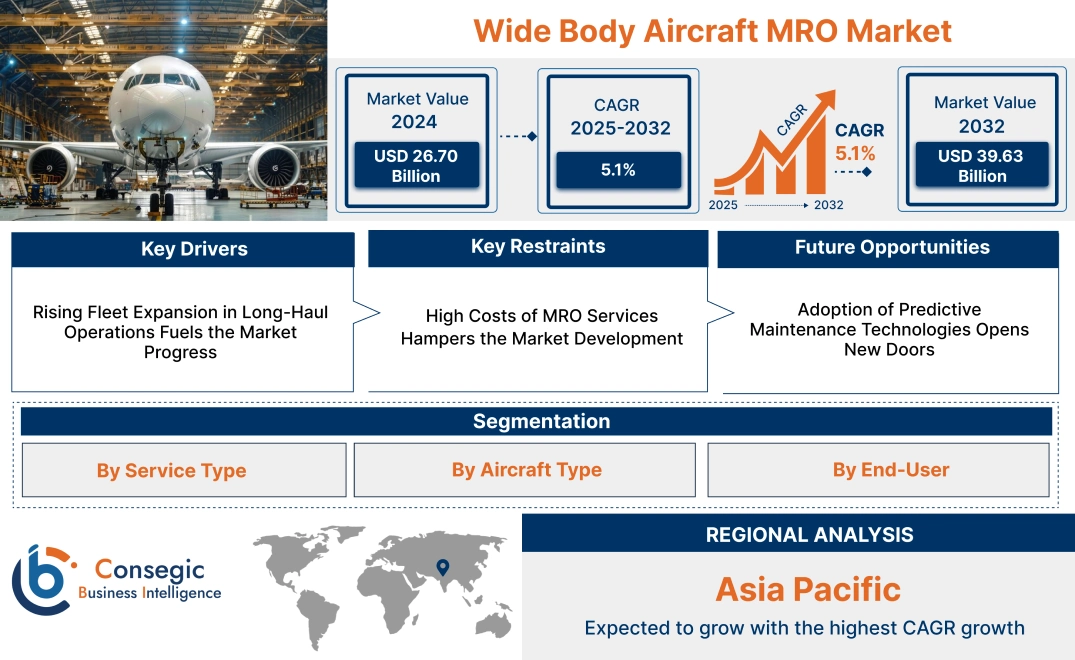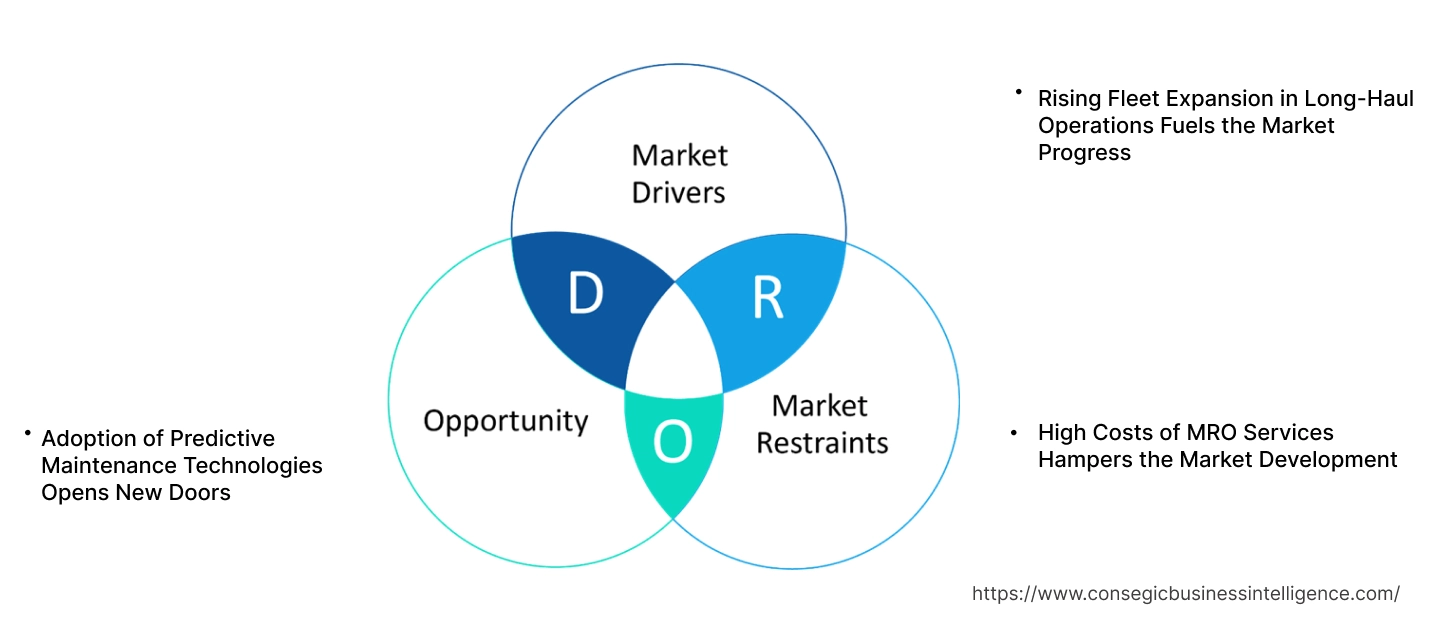- Summary
- Table Of Content
- Methodology
Wide Body Aircraft MRO Market Size:
Wide Body Aircraft MRO Market size is estimated to reach over USD 39.63 Billion by 2032 from a value of USD 26.70 Billion in 2024 and is projected to grow by USD 27.58 Billion in 2025, growing at a CAGR of 5.1% from 2025 to 2032.
Wide Body Aircraft MRO Market Scope & Overview:
Wide body aircraft MRO (Maintenance, Repair, and Overhaul) refers to the services required to ensure the airworthiness, reliability, and operational efficiency of wide body aircraft. These services include routine maintenance, component repair, engine overhauls, and structural inspections, catering specifically to larger aircraft used for long-haul and international operations. MRO activities are essential for meeting regulatory standards and maintaining fleet readiness.
The services are provided by specialized facilities equipped with advanced tools and expertise to handle the unique requirements of wide body aircraft. They involve activities such as avionics upgrades, cabin retrofitting, and landing gear maintenance, ensuring optimal performance and passenger safety. MRO providers offer tailored solutions to airlines, leasing companies, and cargo operators to address both scheduled and unscheduled maintenance needs.
End-users include commercial airlines, military operators, and freight carriers seeking reliable maintenance solutions for their wide body fleets. These services play a critical role in extending the operational lifespan of aircraft and ensuring uninterrupted flight operations.
Key Drivers:
Rising Fleet Expansion in Long-Haul Operations Fuels the Market Progress
Airlines are expanding their wide-body aircraft fleets to meet the growing demand for long-haul international travel, driven by increasing passenger volumes and the resurgence of global tourism post-pandemic. Wide-body aircraft, designed for extended flight ranges and higher passenger capacities, are essential for connecting distant international destinations efficiently. However, their operation necessitates frequent maintenance, repair, and overhaul (MRO) services to ensure compliance with strict aviation safety standards and optimize performance.
Additionally, the increased complexity of wide-body aircraft systems, including advanced engines and avionics, requires specialized MRO expertise, driving further demand in this sector. As airlines strive to enhance operational reliability and passenger safety, the need for routine and advanced MRO services continues to rise, cementing their critical role in supporting fleet expansion and sustaining global long-haul connectivity. Therefore, the aforementioned are driving the wide body aircraft MRO market growth.
Key Restraints:
High Costs of MRO Services Hampers the Market Development
Wide body aircraft MRO services incur significant costs due to the complexity of maintenance operations, advanced diagnostic tools, and the need for highly skilled labor. These aircraft feature intricate systems, such as next-generation engines and avionics, which require specialized expertise and advanced equipment for repairs and overhauls.
Additionally, routine inspections and replacement of high-value components, like landing gear and turbine blades, contribute to escalating expenses. For smaller airlines or operators with limited budgets, these costs act as a barrier, making outsourcing MRO services less feasible. Many of these operators opt for in-house maintenance or delay non-essential repairs, potentially compromising operational efficiency. The high financial burden associated with MRO services, coupled with rising labor and material costs, restricts the broader adoption of outsourced MRO activities, thereby posing constraints to the wide body aircraft MRO market demand.
Future Opportunities :
Adoption of Predictive Maintenance Technologies Opens New Doors
The adoption of predictive maintenance technologies is revolutionizing MRO practices for wide-body aircraft by enhancing efficiency and reducing costs. By integrating IoT-enabled sensors and advanced analytics, aircraft operators monitor critical components in real time and predict potential failures before they occur. This proactive approach minimizes unscheduled downtime, optimizes maintenance schedules, and extends the lifespan of high-value components. Predictive analytics also supports cost-saving measures by identifying specific areas needing attention and reducing unnecessary repairs or replacements.
For MRO providers, the growing reliance on these technologies presents opportunities to offer specialized diagnostic and maintenance services tailored to modern aviation needs. As the aviation industry increasingly prioritizes operational efficiency and safety, predictive maintenance solutions are becoming essential, driving innovation and growth in wide body aircraft MRO market opportunities. This trend aligns with broader digital transformation efforts within the aerospace sector, enhancing competitiveness and customer satisfaction.
Wide Body Aircraft MRO Market Segmental Analysis :
By Service Type:
Based on service type, the market is segmented into engine maintenance, airframe maintenance, component maintenance, line maintenance, and others.
The engine maintenance segment held the largest revenue of 39.5% of the total wide body aircraft MRO market share in 2024.
- Engine maintenance is crucial for ensuring optimal performance and safety, with a focus on overhauls, inspections, and part replacements.
- Increasing air travel demand has elevated the need for consistent engine checks, particularly for high-capacity wide-body aircraft.
- Advanced technologies, including predictive maintenance, are being integrated into engine maintenance to minimize downtime and operational costs.
- The analysis of the segmental trends depicts that the dominance of this segment is attributed to its critical role in maintaining fuel efficiency and extending engine lifespans, contributing to the wide body aircraft MRO market expansion.
The line maintenance segment is expected to register the fastest CAGR during the forecast period.
- Line maintenance services offer real-time, on-ground solutions for routine checks and minor repairs, ensuring operational continuity.
- The rising number of flights and shorter turnaround times are driving the adoption of line maintenance services worldwide.
- Technological advancements, including remote monitoring and automation, are enhancing the effectiveness of line maintenance operations.
- As per the wide body aircraft MRO market analysis, the segment’s rapid growth reflects its role in addressing the immediate needs of wide-body aircraft operators for safety and efficiency.
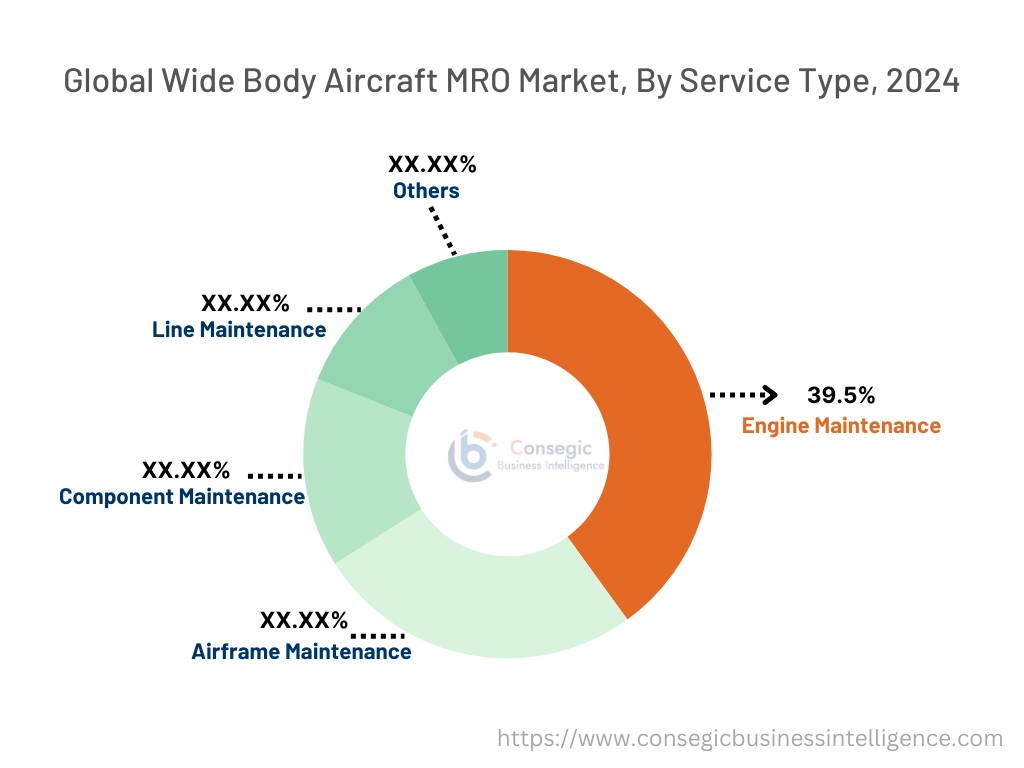
By Aircraft Type:
Based on aircraft type, the market is segmented into passenger aircraft, cargo aircraft, and military aircraft.
The passenger aircraft segment accounted for the largest revenue of the total wide body aircraft MRO market share in 2024.
- The high frequency of operations and passenger volume necessitate regular MRO services to maintain compliance and safety standards.
- Advanced passenger aircraft require comprehensive maintenance due to complex systems, driving segment dominance.
- The increasing fleet size of wide-body passenger aircraft across global carriers is bolstering the need for MRO services.
- As per the wide body aircraft MRO market trends, the segment’s performance is driven by its focus on ensuring passenger comfort and safety during long-haul operations.
The cargo aircraft segment is expected to grow at the fastest CAGR during the forecast period.
- The growth of e-commerce and global trade has increased the operational frequency of cargo aircraft, elevating MRO needs.
- Specialized services, including structural checks and component replacements, are critical for cargo operations.
- Emerging economies are investing in fleet extension, further boosting demand for cargo aircraft MRO services.
- Thus, the segment’s growth is driven by its role in supporting efficient logistics and supply chain management, driving the wide body aircraft MRO market demand.
By End-Use:
Based on end-use, the market is segmented into military and civil.
The civil segment accounted for the largest revenue share in 2024.
- Civil aviation, including commercial airlines and chartered services, requires extensive MRO to ensure safety and regulatory compliance.
- Increasing global connectivity and air travel demand have elevated the need for frequent maintenance schedules in civil aviation.
- The adoption of advanced materials and technologies in civil aircraft MRO enhances operational efficiency and reduces downtime.
- As per the segmental trends analysis, the segment’s dominance reflects its focus on meeting passenger expectations while adhering to stringent safety standards, fueling the wide body aircraft MRO market growth.
The military segment is expected to register the fastest CAGR during the forecast period.
- Military aircraft require specialized MRO services for enhanced operational readiness and mission-critical performance.
- Government investments in defense modernization and fleet extension are driving the need for military aircraft MRO services.
- The incorporation of cutting-edge technologies, including AI and IoT, is optimizing maintenance processes for military applications.
- As per the wide body aircraft MRO market trends, the segment’s rapid growth is attributed to its role in ensuring the reliability and longevity of defense aircraft operations.
Regional Analysis:
The regions covered are North America, Europe, Asia Pacific, the Middle East and Africa, and Latin America.
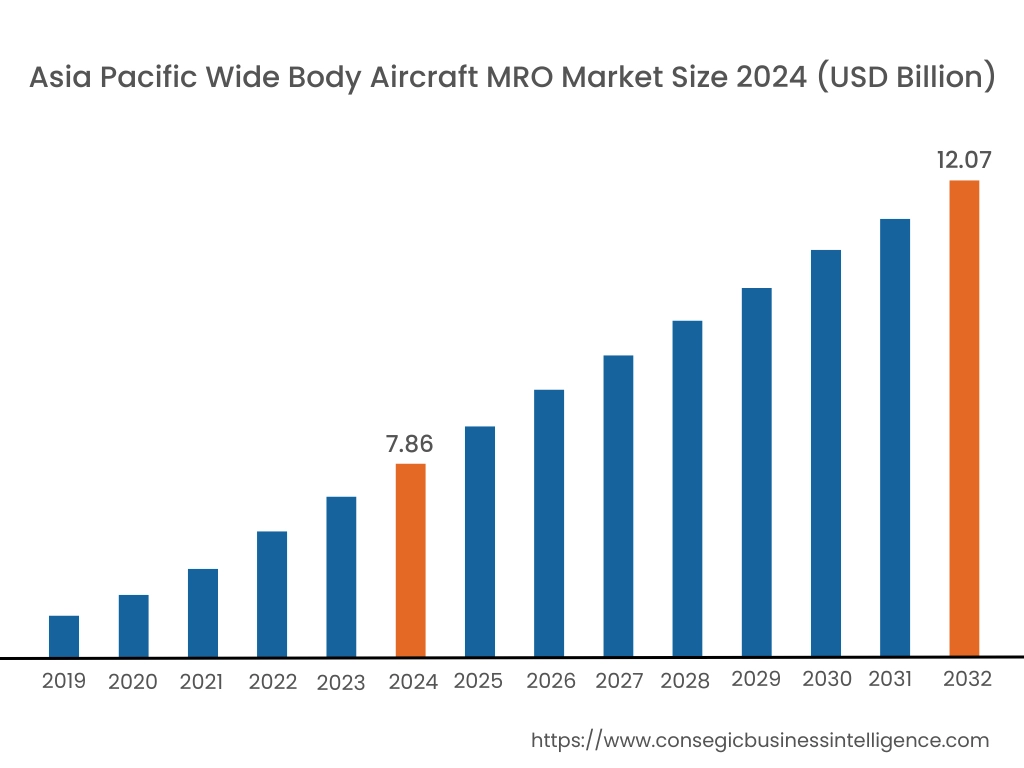
Asia Pacific region was valued at USD 7.86 Billion in 2024. Moreover, it is projected to grow by USD 8.14 Billion in 2025 and reach over USD 12.07 Billion by 2032. Out of this, China accounted for the maximum revenue share of 35.1%. The Asia-Pacific region is witnessing rapid advancements in the wide body aircraft MRO market, driven by the expanding aviation sector in countries like China and India. The increasing number of wide-body aircraft in service necessitates comprehensive MRO services to ensure safety and efficiency. As per the wide body aircraft MRO market analysis, technological improvements and government initiatives supporting the aviation industry are projected to generate profitable prospects for the MRO sector.
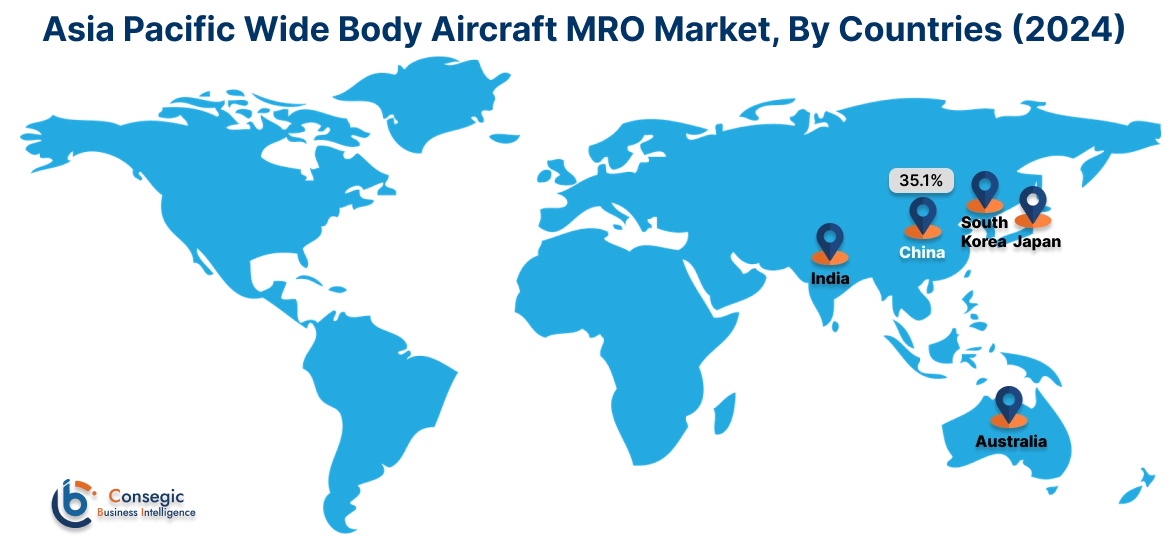
North America is estimated to reach over USD 12.84 Billion by 2032 from a value of USD 8.86 Billion in 2024 and is projected to grow by USD 9.13 Billion in 2025. This region maintains a substantial share of the wide body aircraft MRO market, primarily due to the extensive fleet of wide-body aircraft operated by major airlines. The presence of leading MRO service providers further strengthens the market. A notable trend is the increasing adoption of advanced diagnostic and predictive maintenance technologies to enhance operational efficiency. Analysis indicates that the focus on extending aircraft lifespan and ensuring regulatory compliance continues to drive wide body aircraft MRO market opportunities in this region.
European countries such as Germany, France, and the United Kingdom are significant players in the wide body aircraft MRO market. The region's emphasis on maintaining a robust aviation sector has led to substantial investments in MRO facilities and capabilities. A significant trend is the collaboration among airlines and MRO providers to develop sustainable maintenance practices, aligning with environmental regulations.
The Middle East serves as a key hub for long-haul international flights, contributing to the need for wide body aircraft MRO services. Nations like the United Arab Emirates are investing in innovative MRO solutions to enhance service delivery and comply with international standards. Analysis suggests an emerging trend towards adopting advanced maintenance technologies to improve operational efficiency.
Latin America is an emerging market for wide body aircraft MRO services, with countries such as Brazil and Mexico contributing to its development. The region's focus on modernizing aviation infrastructure and improving operational efficiency has spurred interest in MRO solutions. Government policies aimed at enhancing technological capabilities influence wide body aircraft MRO market expansion.
Top Key Players and Market Share Insights:
The Wide Body Aircraft MRO market is highly competitive with major players providing products and services to the national and international markets. Key players are adopting several strategies in research and development (R&D), product innovation, and end-user launches to hold a strong position in the global Wide Body Aircraft MRO market. Key players in the Wide Body Aircraft MRO industry include -
- Lufthansa Technik (Germany)
- Air France-KLM Engineering & Maintenance (France)
- GE Aviation (USA)
- Rolls-Royce plc (UK)
- MTU Aero Engines (Germany)
- Delta TechOps (USA)
- ST Engineering Aerospace (Singapore)
- AAR Corp. (USA)
- HAECO (Hong Kong Aircraft Engineering Company Limited) (Hong Kong)
Recent Industry Developments :
Service Launches:
- In May 2023, Fokker Services Group inaugurated a new wide-body hangar in Hoogerheide, Netherlands, designed for aircraft like A330, A350, B787, and B777. Featuring sustainable innovations, it is fully electric, includes a geothermal energy system, and will have rooftop solar panels. The hangar's modular design reduces construction CO2 emissions by 75%. Highlighted during EBACE 2023, FSG aims to lead in wide-body airframe maintenance and completions, supported by advanced technology and its extensive aerospace history.
Partnerships & Collaborations:
- In July 2024, Sanad partnered with Air Mauritius in an exclusive three-year agreement to provide Maintenance, Repair, and Overhaul (MRO) services for Rolls Royce Trent 700 engines. Signed at the Farnborough International Airshow, this collaboration underscores Sanad's expertise as the only independent Trent 700 MRO provider globally, operating from its Abu Dhabi base. The partnership supports Air Mauritius' Airbus A330 operations across its international routes and reinforces Abu Dhabi's stature as a global aviation hub. This milestone expands Sanad's market reach and customer base.
- In November 2023, Emirates and Boeing partnered to enhance aircraft maintenance using advanced digital technologies like drone-assisted inspections, augmented reality, and predictive analytics. These innovations aim to improve operational reliability, reduce maintenance time, and optimize fleet performance, particularly for Emirates' Boeing 777s. Drone inspections will detect surface issues, while AR tools enable precise diagnostics without dismantling components. Predictive maintenance leverages analytics for better decision-making. Emirates Engineering’s state-of-the-art facilities support the world's largest fleets of Boeing 777 and Airbus A380 aircraft.
Wide Body Aircraft MRO Market Report Insights :
| Report Attributes | Report Details |
| Study Timeline | 2019-2032 |
| Market Size in 2032 | USD 39.63 Billion |
| CAGR (2025-2032) | 5.1% |
| By Service Type |
|
| By Aircraft Type |
|
| By End-Use |
|
| By Region |
|
| Key Players |
|
| North America | U.S. Canada Mexico |
| Europe | U.K. Germany France Spain Italy Russia Benelux Rest of Europe |
| APAC | China South Korea Japan India Australia ASEAN Rest of Asia-Pacific |
| Middle East and Africa | GCC Turkey South Africa Rest of MEA |
| LATAM | Brazil Argentina Chile Rest of LATAM |
| Report Coverage |
|
Key Questions Answered in the Report
What is the size of the Wide Body Aircraft MRO Market? +
The Wide Body Aircraft MRO Market size is estimated to reach over USD 39.63 Billion by 2032 from a value of USD 26.70 Billion in 2024 and is projected to grow by USD 27.58 Billion in 2025, growing at a CAGR of 5.1% from 2025 to 2032.
What are the key segments in the Wide Body Aircraft MRO Market? +
The market is segmented by service type (engine maintenance, airframe maintenance, component maintenance, line maintenance, and others), aircraft type (passenger aircraft, cargo aircraft, and military aircraft), and end-use (military and civil).
Which segment is expected to grow the fastest in the Wide Body Aircraft MRO Market? +
The line maintenance segment is expected to register the fastest CAGR during the forecast period, driven by the rising number of flights and shorter turnaround times.
Who are the major players in the Wide Body Aircraft MRO Market? +
Major players in the Wide Body Aircraft MRO Market include Lufthansa Technik (Germany), Air France-KLM Engineering & Maintenance (France), Delta TechOps (USA), ST Engineering Aerospace (Singapore), AAR Corp. (USA), HAECO (Hong Kong), MTU Aero Engines (Germany), GE Aviation (USA), and Rolls-Royce plc (UK).
